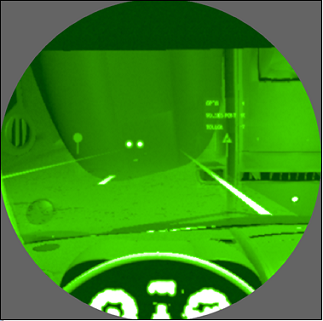Parameters of Night Vision Goggles
Technology
In Technology box, you can select night vision goggles of generation II (Gen II) or generation III (Gen III).
With Gen III class A, B or C, you can define a NVG of generation III with a filter in the objective lens to restrict the response in the visible range.
Class A defines a 625nm minus blue filter.
Class B defines a 665nm minus blue filter.
Class C defines a leaky green filter.
Field of View
In Field of view, you must set the field of view value in degrees.
System Resolution
In System Resolution box, you must set the resolution value in cycles per milliradians.
The system resolution at the center of the image is the ability of night vision goggles to distinguish between objects close together.
Signal to Noise Ratio
In Signal to noise ratio box, you must type a ratio value.
A measure of the light signal reaching the eye divided by the perceived noise as seen by the eye.
A tube's SNR determines the low light resolution of the image tube. Therefore higher is the SNR, better is the ability of the tube to resolve objects with good contrast under low light conditions.
System Luminance Gain
In System luminance gain box, you must type the luminance gain value.
System luminance gain is the ratio of NVG output's luminance to input's luminance. Units are in foot-lamberts.
Max. Average Output Luminance
In Max. average output luminance box, you must type the maximal average output luminance value in foot-lamberts.
Maximal average output luminance is the maximal output luminance averaged across the full field of view.
When observed luminance increases, the luminance system gain is reduced to keep average luminance of the phosphor screen below this value.
Phosphor Screen Spectrum
In Phosphor screen spectrum box, you must click ![]() to browse a .spectrum or .spe file to define the spectrum of the phosphor screen.
to browse a .spectrum or .spe file to define the spectrum of the phosphor screen.
 to display the spectrum.
to display the spectrum.Additional Filter
In Additional filter box, you must click ![]() to browse a .spectrum or .spe file to simulate a filter used in the input of the night vision
goggle.
to browse a .spectrum or .spe file to simulate a filter used in the input of the night vision
goggle.
 to display the spectrum.
to display the spectrum.Blooming
You can select the Blooming check box to access the parameters setting the blooming simulation. Blooming is a sort of halo effect around visible light sources. When a bright light source comes into the night vision device's view, there can be a complete or partial loss of the entire night vision image, due to intensifier tube overloading. The night vision scene becomes much brighter, whiting out objects in the field of view.
Set the FWHM to define the width value of the gaussian half-way up in millimeter.
Set the Threshold in foot-lamberts do define the luminance threshold at which a defined point is considered as a blooming source.
Set the Halo Limit to define the size of the blooming in percentage.
Warning: If the value of the gaussian filter used to simulate the blooming is lower than this percentage, no blooming is displayed.
 |
 |
Night vision simulation taking blooming into account |
Night vision simulation not taking blooming into account |


